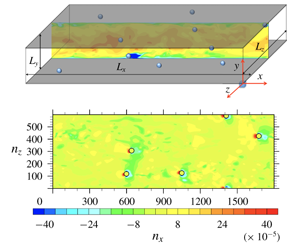Article contents
Flow modulation by a few fixed spherical particles in a turbulent channel flow
Published online by Cambridge University Press: 09 December 2019
Abstract

Current understanding of turbulence modulation by solid particles is incomplete as making reliable predictions on the nature and level of modulation remains a challenging task. Multiple modulation mechanisms may be simultaneously induced by particles, but the lack of reliable methods to identify these mechanisms and quantify their effects hinders a complete understanding of turbulence modulation. In this work, we present a full analysis of the turbulent kinetic energy (TKE) equation for a turbulent channel flow laden with a few fixed particles near the channel walls, in order to investigate how the wall generated turbulence interacts with the particles and how, as a result, the global turbulence statistics are modified. All terms in the budget equations of total and component-wise TKEs are explicitly computed using the data from direct numerical simulations. Particles are found to modify turbulence by two competing mechanisms: the reduction of the intrinsic turbulence production associated with a reduced mean shear due to the resistance imposed by solid particles (the first mechanism), and an additional TKE production mechanism by displacing incoming fluid (the second mechanism). The distribution of TKE in the wall-normal direction is also made more homogeneous due to the significantly enhanced pressure transport of TKE. Finally, the budget analysis of component-wise TKE reveals an enhanced inter-component TKE transfer due to the presence of particles, which leads to a more isotropic distribution of TKE among three velocity components.
- Type
- JFM Papers
- Information
- Copyright
- © 2019 Cambridge University Press
References
- 11
- Cited by




